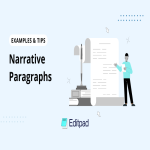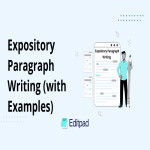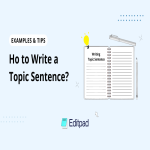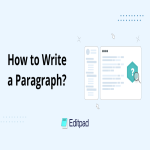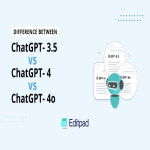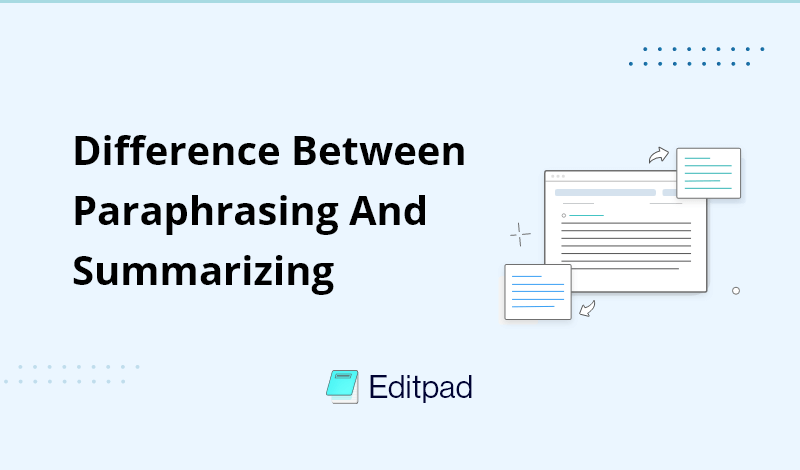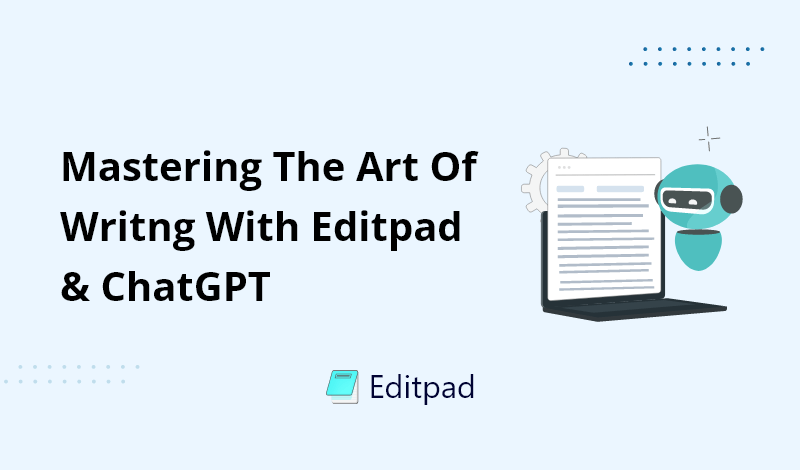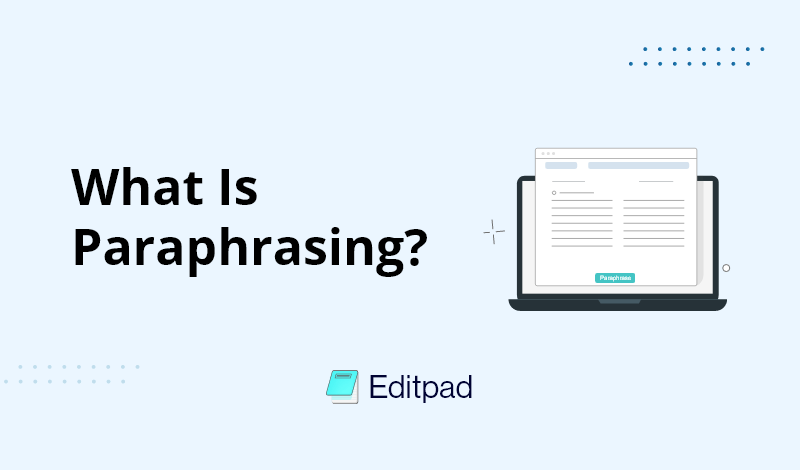Structure of an expository paragraph:
How to write an expository paragraph?
Tips for writing expository paragraphs:
Alternative Way to Quickly Craft High-Quality Expository Paragraphs
Expository writing is a style of writing that focuses on sharing information or explaining something in a clear way. It does not try to convince the reader to think a certain way or share the writer's personal feelings. Instead, it uses facts, examples, and expert opinions to help the reader understand a topic better.
The word expository is derived from the English word “expose” which means to show, reveal, or display. This type of writing is commonly used in academic, journalistic, and professional contexts where clear and factual communication is essential.
In this article, we will talk about the structure and process of writing expository paragraphs with examples. We will also look at some tips that help to improve the quality of an expository piece of writing.
A typical expository paragraph is divided into three main parts.
2. Supporting sentences
3. Closing sentence
Let’s see what are they with the help of an example:
“Solar energy is becoming an increasingly important alternative to traditional fossil fuels. Solar panels convert sunlight into electricity without any harmful emissions. According to the Solar Energy Industries Association, the cost of solar panels has dropped by more than 70% since 2010, making them more accessible. Many cities in California now require solar panels on new homes, highlighting solar energy's growing popularity. As a result, solar energy not only supports environmental sustainability but also offers economic benefits to users.”
This is the foundation of the paragraph. The introductory sentence starts the paragraph and shows what it will be about, introducing the main idea or point that will be explained further in the paragraph. It tells the reader what to expect.
It should be clear, concise, and directly related to the overall topic.
From the example:
“Solar energy is becoming an increasingly important alternative to traditional fossil fuels.”
This section consists of at least 2 to 3 supporting sentences that provide all necessary information and explanations. These are the building blocks. They explain or support the topic sentence. They can be facts, examples, definitions, statistics, or quotes.
From the example:
“Solar panels convert sunlight into electricity without any harmful emissions.
According to the Solar Energy Industries Association, the cost of solar panels has dropped by more than 70% since 2010, making it more accessible.
Many cities in California now require solar panels on new homes, highlighting solar energy's growing popularity.”
This sentence summarizes the main point of the paragraph and reinforces the topic sentence.
From the example:
“As a result, solar energy not only supports environmental sustainability but also offers economic benefits to users.”
(Helpful SlideShare presentation on the detailed structure and purpose of expository paragraphs)
The process of writing a good expository paragraph includes the following steps.
Search for information about the topic before you start the paragraph. You should have a clear idea of your topic. Knowing exactly what you want to write about will help you find the right stuff.
Once your topic is defined, brainstorm a list of keywords and phrases related to your topic. These terms will help you in searching databases, libraries, and online resources.
For example, if your topic is “Climate change” then the related keywords will be “global warming, greenhouse gasses, carbon emissions, climate crisis, renewable energy, sustainability, polar ice caps, sea level rise, extreme weather”
When you’re gathering material on your topic, it’s important to find good sources. Avoid using information from personal blogs or unverified online sources. Look for information from:
â Academic Journals: Peer-reviewed journals provide reliable and scholarly information.
â Books: Books from respected publishers offer in-depth coverage of topics.
â Government and Educational Websites: Sites ending in .gov or .edu provide authoritative information.
â Established News Organizations: For current events and recent developments.
As you find different sources of information, make sure they are useful and dependable. Look at who wrote the information, when it was written, and the situation in which it was created. Organize your research by taking notes and writing down the main points that are important for your topic.
(How to use sources in an expository essay by UMGC)
When you write the first sentence of your paragraph, make sure it's interesting and grabs the reader’s attention right away. This sentence should give a clear idea of what the paragraph will be about and hint at the upcoming details, making it easy for the reader to understand.
Example:
"Dogs are popular animals all over the world." (Boring)
This is a dull topic sentence. you could write something more engaging like
"Due to their loyal and adaptable nature, dogs have become the most popular household pets worldwide." (Interesting)
This sentence is more attractive and gives a sneak peek into why dogs are loved by so many, setting up the paragraph for more details.
It’s important to keep your sentence well-organized because a confusing start can make the whole paragraph hard to understand.
Example:
"Climate change affects many things like the weather, animals, and all different places around the world, and there are gases involved." (Unorganized)
This sentence is confusing because it tries to cover too much at once and jumps from one idea to another without a clear focus.
"Climate change, driven by increased carbon emissions from industrial activities, is intensifying global warming and altering weather patterns worldwide." (Organized)
This sentence is clear and focused. It links climate change directly to its cause (carbon emissions) and its effects (global warming and changing weather patterns), setting a specific topic for the paragraph.
If your topic includes things that everyone might not know about, it’s a good idea to give a little background information right at the beginning.
Example:
"Quantum computing is a fascinating field with a lot of potential." (Unclear topic)
This sentence, while true, does not explain what quantum computing is or why its potential is significant.
"Quantum computing, which uses the rules of quantum mechanics to process information much faster than traditional computers, represents a revolutionary advancement in technology." (Clear topic)
In this topic sentence, the key concept of "quantum mechanics" is briefly introduced right at the start.
(Topic sentence examples for better writing by Udemy’s blog)
The body of your expository paragraph consists of supporting sentences. This is where you provide detailed explanations and clarifications. These details should be facts, examples, statistics, or quotes from experts.
Make sure each piece of information is directly related to the topic sentence and adds value to your explanation. Depending on your specific type of expository writing, you may include:
â Facts and Statistics: Introduce accurate data to back up your statements.
â Examples: Use specific examples to illustrate your points more vividly.
â Quotes: Incorporate expert opinions to add credibility to your explanation.
Expository writing should be easy to understand, so avoid complex vocabulary or overly complicated sentence structures. The goal is to convey information in the most straightforward manner possible. Be direct and clear to make sure each sentence contributes to your overall explanation.
Transitional words help link your ideas smoothly, showing how they are connected. Phrases like "for instance," "in addition," "furthermore," and "however" can help maintain the flow of your paragraph and guide the reader through your explanations.
Remember, the goal is to help your reader fully comprehend the topic or issue you're discussing.
Example:
For the topic of climate change, let’s write 4 supporting sentences.
According to data from NASA, the last decade has seen the highest global surface temperatures in recorded history. (Fact)
For instance, in regions like the Arctic, warming temperatures have accelerated the melting of polar ice caps. This has resulted in a rise in sea levels, posing threats to coastal communities around the globe. (Example)
The Intergovernmental Panel on Climate Change (IPCC) reports that carbon emissions have increased by over 50% since 1990, further exacerbating the climate crisis. (Statistics)
Furthermore, this increase in global temperatures causes more frequent and severe weather events, such as hurricanes and wildfires, impacting ecosystems and human populations alike. (Further explanation)
(PDF on main ideas and supporting details of a paragraph)
End your paragraph with a sentence that summarizes the information you've presented or prepares the reader for the next paragraph.
The purpose of the concluding sentence is to remind the reader of the central issue of the paragraph. This doesn't mean repeating the topic sentence word for word. Instead, it's about presenting the main idea in a slightly different way.
It should also add value to the paragraph by offering a final piece of insight or a clarifying statement. This could be a summary of the information you've provided, a brief explanation of why this information is important, or how it could be applied.
For the previously-mentioned example of “climate change”, the concluding sentence would be:
“Thus, the link between industrial carbon emissions and the acceleration of climate change highlights the urgent need for sustainable energy solutions to mitigate these profound environmental impacts.”
(Learn to write a concluding sentence with examples by EWritingService)
After writing your paragraph, take the time to review and revise it. Check for grammatical errors, ensure that the information flows logically, and confirm that all supporting details increase the understanding of the topic sentence. It might help to read the paragraph out loud to see if it sounds natural and makes sense.
(More on writing an expository paragraph at indeed.com)
“Tip: Editpad AI Paragraph Generator can help you write all of these steps in just one click.”
Expository writing is all about explaining and informing your readers in a clear and concise manner. To ensure your expository writing is effective, here are a few tips:
One of the core principles of expository writing is to remain objective. This means focusing on presenting facts, data, and evidence without sharing personal opinions.
The purpose of expository writing is “to explain” not “to persuade”. Always provide information in a way that lets readers make up their own minds. Therefore, don't use words that show you prefer one side over another.
Clear and straightforward language is important in expository writing. Write in a way your readers can understand the topic without confusion or misunderstanding.
Don’t use complicated words or too much technical language that your readers might not know. If you have to use a difficult term, make sure to explain what it means the first time you use it.
(5 Tips for expository writing - Video by Empowering Writers)
Expository writing is used on various platforms differently. In writing an expository paragraph, it is important to select a suitable type of writing according to your topic.
It is also essential to keep one tone or style of expository writing throughout the paragraph. Below are the different ways an expository paragraph can be written along with a few suitable applications.
1. Definitive
This style is all about giving clear definitions and detailed descriptions. It uses examples to help explain things better. This kind of writing is often found in textbooks or academic articles where exact details are important.
2. Sequential/Process
This method shows you how to do something step by step. It's great for instructions, like recipes or DIY projects, making it easy for readers to follow along and do things themselves.
3. Comparative
This style compares two or more things to show their similarities and differences. For example, It can be used to compare lifestyle choices, education methods, and gadgets. It helps readers understand the pros and cons of each side, making the writing more engaging.
4. Cause/Effect
This approach looks at why things happen (causes) and what happens as a result (effects). It's used a lot in blogs that talk about personal experiences, like changing a diet or starting exercise, showing readers the real-world results of these actions.
5. Problem/Solution
This tone focuses on pointing out a problem and then discussing possible solutions. It’s straightforward and uses facts and data, keeping opinions out. It is used for presenting different issues like economic, social, environmental, etc., and providing their solution.
6. Classification
This method breaks down a big topic into smaller groups or categories. This is helpful in complex subjects like health, technology, and nature, making them easier to understand by sorting information into clear groups.
(More about the types of expository paragraphs in a guide by Study.com)
From what we’ve discussed above, it can be easily established that writing expository paragraphs is not a walk in the park. Effectively doing so will require a lot of your effort and time.
Fortunately, there is another way to go about this, one that’s quicker and more reliable as well. It is to utilize Editpad’s AI Paragraph Generator. The tool uses artificial intelligence and natural language processing to create engaging paragraphs against the user’s prompt.
You won’t have to research the topic much yourself or write the introduction, body, and concluding sentence manually. The tool will do it for you. Having said that, the following steps have to be followed to use it.
â Enter the topic that you want to generate a paragraph for into the provided box.
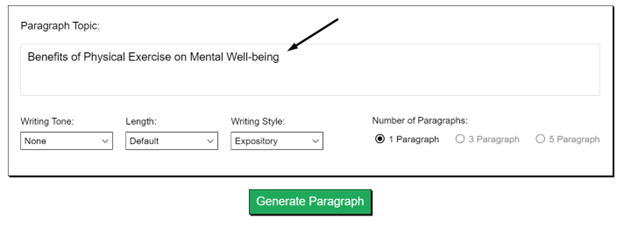
â Multiple tones of voice are provided to users. Select which one you’d like the generated paragraph to be in.
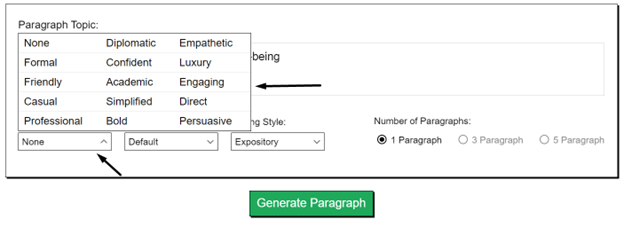
â Our paragraph generator can generate expository paragraphs of multiple lengths, so choose how long you want the output to be.
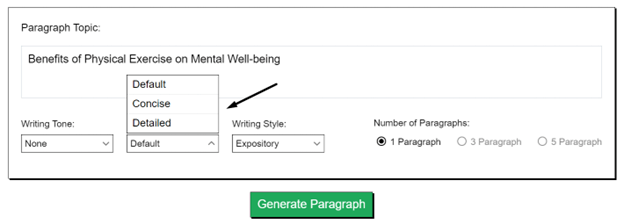
â Next, you have to pick what type of paragraph the tool shall provide. In this case, it’s obviously going to be expository, so choose it from the provided options.
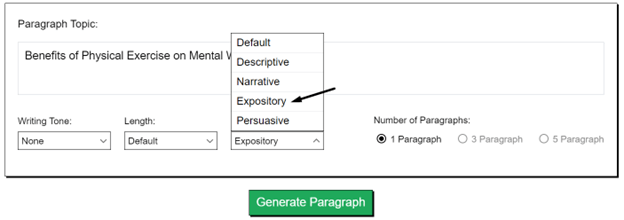
â Lastly, select the number of paragraphs that are needed. Note that each generated paragraph will be a bit different so you can choose one you like most.
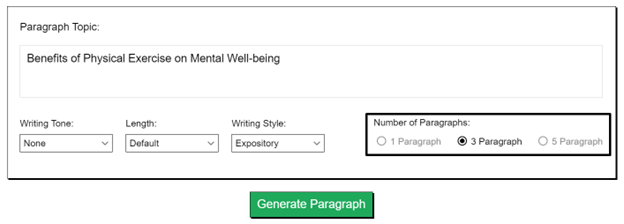
Once all this is done, all that’s left to do is to hit the “Generate Paragraph” button and the AI Paragraph Generator by Editpad will provide a response in a few seconds. Against the title we entered, the paragraphs we got are as follows:
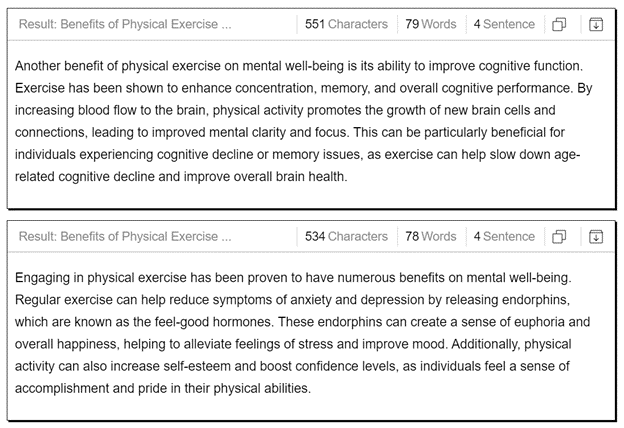
The generated expository paragraphs are coherent and well-written. They include enough information and have a clear introductory sentence as well as body and conclusion sentences.
â A detailed Nancy Fetzer’s PDF guide on expository paragraph and their writing.
â 10 tips for expository essays on recruitment.relaypub.com
â A comprehensive guide on Expository paragraphs by BC Open Textbook
â 5+ examples of expository paragraphs by 5StarEssays
â Indeed's article on Expository writing: definition and examples
â Helpful video resource by Andie Worsley on expository writing

